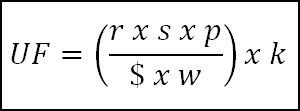The Jon Peddie Research review team create an Ultra Factor formula and weigh the results.
By Jon Peddie, Robert Dow, and Harrison Gorvy
At the recent Intel Developers Forum we saw some delightful Ultrabooks. There are many now, possibly more than two dozen to choose from, with more on the way. However, there are some differences in them and a value proposition to comprehend.

From our myopic pixel-oriented POV we looked at what you get in performance, screen, resolution, price, and weight… and created the Ultra factor:
Where: UF = Ultra Factor
R = resolution – pixels
S = screen size – inches
P = processor I class (3,5,7)
$ = price – dollars
W = weight – pounds
K = coefficient – 0.001
We then surveyed 19 Ultrabooks and generated this table:
| Ultrabooks | Screen | Pixel | Lines | CPU | lbs | Price | UF |
| Asus Zenbook Prime | 13.3 | 1920 | 1080 | i7 | 3.1 | $780 | 80 |
| Acer Aspire S5 | 13.3 | 1366 | 768 | i7 | 2.6 | $825 | 46 |
| Vizio C14-A2 | 14 | 1600 | 900 | i7 | 3.4 | $1,199 | 35 |
| Asus Zenbook UX31E-DH52 | 13.3 | 1600 | 900 | i5 | 2.9 | $1,005 | 33 |
| HP ENVY Spectre XT Ultrabook 13t-2000 | 13.3 | 1366 | 768 | i7 | 3 | $999 | 33 |
| Dell Inspiron 14z | 14 | 1366 | 768 | i5 | 4.1 | $600 | 30 |
| Sony VAIO T Series Ultrabook | 13.3 | 1366 | 768 | i7 | 3.5 | $969 | 28 |
| Toshiba Portégé Z830 Series | 13.3 | 1366 | 768 | i7 | 2.5 | $1,429 | 28 |
| Dell XPS 14 | 14 | 1600 | 900 | i7 | 4.7 | $1,100 | 27 |
| Lenovo IdeaPad U310 | 13.3 | 1366 | 768 | i5 | 3.7 | $700 | 27 |
| Sony VAIO T Series Ultrabook | 13.3 | 1366 | 768 | i5 | 3.5 | $739 | 27 |
| Toshiba Satellite U845W-S410 | 14.4 | 1792 | 768 | i5 | 3.7 | $999 | 27 |
| Average | 13.7 | 1462 | 810.0 | 5.9 | 3.4 | $1,062 | 27 |
| Toshiba Portege Z930-BT9300 Ultrabook | 13.3 | 1366 | 768 | i5 | 2.5 | $1,150 | 25 |
| Dell XPS 13 | 13.3 | 1366 | 768 | i7 | 3 | $1,429 | 23 |
| HP Envy Ultrabook 4-1030us | 14 | 1366 | 768 | i5 | 3.9 | $830 | 23 |
| Samsung Series 9 NP900 | 15 | 1600 | 900 | i7 | 3.6 | $1,800 | 23 |
| Toshiba Satellite U845-S406 | 14 | 1366 | 768 | i5 | 3.7 | $850 | 23 |
| Acer Aspire TimelineUltra M5 | 15.6 | 1366 | 768 | i5 | 4.5 | $829 | 22 |
| Fujitsu Lifebook UH572 | 13.3 | 1366 | 768 | i5 | 3.5 | $999 | 20 |
| Sony SVT13114GXX | 13.3 | 1366 | 768 | i5 | 3.4 | $1,999 | 10 |
On the basis of this evaluation the Asus Zenbook is the clear winner. However, this makes no compensation for GPU. In a review to be posted to GraphicSpeak in a day or two, you will see the GPU in the Zenbook contributes nothing to the performance of the machine and is easily beaten by the A9 Trinity. But since the Trinity laptop on hand isn’t an Ultrabook, and we don’t have samples of all the others, we can’t run benchmarks on them—but for the machines we have, we will show results. [Editor’s Note: When the review is available, a link will replace this sentence.]
Our take
A 13-inch screen is a joke, slightly larger than a tablet. And 1366 x 768—jeeze—let’s go back to 1987 and enjoy XGA all over again. Is this really the best the industry can do? If a 13-inch screen with 786 lines (and may we point out the Apple iPad has 2048 x 1536 resolution) is all the PC industry can deliver then it deserves to get eaten alive by tablets because it not only has it failed the consumer, it has insulted the consumer.
Robert and Harrison work for Jon Peddie Research, of which Jon is President.






